The Man in a Case_装在套子里的人英语读后感
装在套子里的人读后感(优秀5篇)
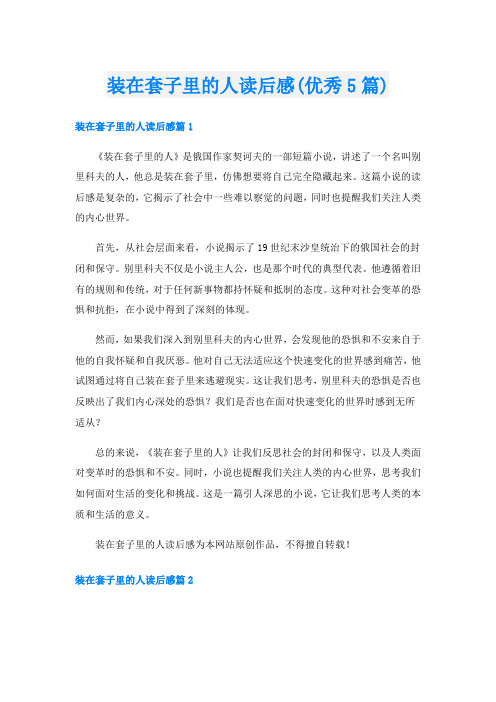
装在套子里的人读后感(优秀5篇)装在套子里的人读后感篇1《装在套子里的人》是俄国作家契诃夫的一部短篇小说,讲述了一个名叫别里科夫的人,他总是装在套子里,仿佛想要将自己完全隐藏起来。
这篇小说的读后感是复杂的,它揭示了社会中一些难以察觉的问题,同时也提醒我们关注人类的内心世界。
首先,从社会层面来看,小说揭示了19世纪末沙皇统治下的俄国社会的封闭和保守。
别里科夫不仅是小说主人公,也是那个时代的典型代表。
他遵循着旧有的规则和传统,对于任何新事物都持怀疑和抵制的态度。
这种对社会变革的恐惧和抗拒,在小说中得到了深刻的体现。
然而,如果我们深入到别里科夫的内心世界,会发现他的恐惧和不安来自于他的自我怀疑和自我厌恶。
他对自己无法适应这个快速变化的世界感到痛苦,他试图通过将自己装在套子里来逃避现实。
这让我们思考,别里科夫的恐惧是否也反映出了我们内心深处的恐惧?我们是否也在面对快速变化的世界时感到无所适从?总的来说,《装在套子里的人》让我们反思社会的封闭和保守,以及人类面对变革时的恐惧和不安。
同时,小说也提醒我们关注人类的内心世界,思考我们如何面对生活的变化和挑战。
这是一篇引人深思的小说,它让我们思考人类的本质和生活的意义。
装在套子里的人读后感为本网站原创作品,不得擅自转载!装在套子里的人读后感篇2《装在套子里的人》是俄国作家契诃夫的一部短篇小说,讲述了一个名叫别里科夫的人,他总是装在套子里,仿佛要把自己完全隐藏起来。
这篇小说的读后感让人深思,探讨了人类与社会之间的关系,以及如何面对变革。
首先,从别里科夫这个人物来看,他的行为和思想让人感到恐惧。
他总是穿着套鞋、带着墨镜,甚至在晴天也穿着雨衣出门。
他的生活被限制在一个固定的模式中,他害怕变革,甚至害怕听到有关政治的新鲜事。
这种恐惧和不安在他的言语和行为中表现得淋漓尽致。
他的套子不仅仅是一种保护,更是一种自我封闭和自我隔离。
其次,小说中的另一个重要角色是中学教师布尔金,他与别里科夫的交往表现出一种对未来不确定性的恐惧。
装在套子里的人读后感10篇
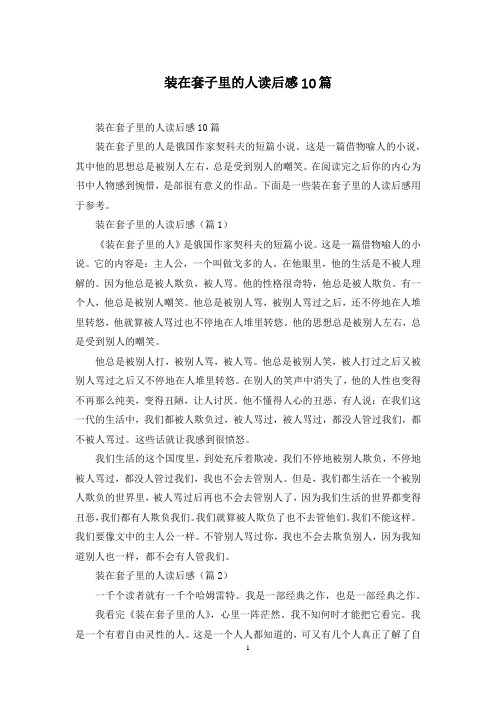
装在套子里的人读后感10篇装在套子里的人读后感10篇装在套子里的人是俄国作家契科夫的短篇小说。
这是一篇借物喻人的小说,其中他的思想总是被别人左右,总是受到别人的嘲笑。
在阅读完之后你的内心为书中人物感到惋惜,是部很有意义的作品。
下面是一些装在套子里的人读后感用于参考。
装在套子里的人读后感(篇1)《装在套子里的人》是俄国作家契科夫的短篇小说。
这是一篇借物喻人的小说。
它的内容是:主人公,一个叫做戈多的人。
在他眼里,他的生活是不被人理解的。
因为他总是被人欺负,被人骂。
他的性格很奇特,他总是被人欺负。
有一个人,他总是被别人嘲笑。
他总是被别人骂,被别人骂过之后,还不停地在人堆里转悠,他就算被人骂过也不停地在人堆里转悠。
他的思想总是被别人左右,总是受到别人的嘲笑。
他总是被别人打,被别人骂,被人骂。
他总是被别人笑,被人打过之后又被别人骂过之后又不停地在人堆里转悠。
在别人的笑声中消失了,他的人性也变得不再那么纯美,变得丑陋,让人讨厌。
他不懂得人心的丑恶。
有人说:在我们这一代的生活中,我们都被人欺负过,被人骂过,被人骂过,都没人管过我们,都不被人骂过。
这些话就让我感到很愤怒。
我们生活的这个国度里,到处充斥着欺凌。
我们不停地被别人欺负,不停地被人骂过,都没人管过我们,我也不会去管别人。
但是,我们都生活在一个被别人欺负的世界里,被人骂过后再也不会去管别人了,因为我们生活的世界都变得丑恶,我们都有人欺负我们。
我们就算被人欺负了也不去管他们。
我们不能这样。
我们要像文中的主人公一样。
不管别人骂过你,我也不会去欺负别人,因为我知道别人也一样,都不会有人管我们。
装在套子里的人读后感(篇2)一千个读者就有一千个哈姆雷特。
我是一部经典之作,也是一部经典之作。
我看完《装在套子里的人》,心里一阵茫然。
我不知何时才能把它看完。
我是一个有着自由灵性的人。
这是一个人人都知道的,可又有几个人真正了解了自己。
我不敢说我真的很爱《白夜行》,但我真的很爱这部小说。
《装在套子里的人》读后感范文5篇

《装在套子里的人》读后感范文5篇《装在套子里的人》读后感范文5篇1我读过一篇__,叫《装在套子里的人》,在实际生活中,我也见过这样的人。
他是我爸爸的一个朋友。
书上说:“他也真怪,即使在最晴朗的日子,也要穿上雨鞋,带上雨伞,而且一定穿着暖和的棉大衣。
他总是把雨伞装在套子里,把表放在一个灰色的鹿皮套子里,就连削铅笔的小刀,也是装在一个小套子里的。
他的脸也好像蒙着套子,因为他老是把它藏在竖起的衣领里。
他带黑眼镜,穿羊毛衫,用棉花堵住耳朵。
总之,这人总想把自己包在壳子里,仿佛要为自己制造一个套子,好隔绝人世,不受外界影响。
现实生活刺激他,惊吓他,老是弄得他六神不安。
”他把他的思想也极力藏在一个套子里。
这种人心理上不快乐,老想着隔绝人世,不乐观。
听见流言,说是中学出了事,他就一个劲地说:“千万别闹出什么乱子。
”他那种慎重,那种多疑,那种纯粹套子式的论调,简直压得我们透不过气来。
是啊,装在套子里的人太多疑,太小心,太封建,太悲观,太谨慎。
在这些人的影响下,人们不敢大声说话,不敢写信,不敢交朋友。
这种人性格孤辟,我们不能跟他们一样。
《装在套子里的人》全文一万余字,采用故事套故事的形式,借中学教师布尔金之口讲述有关别里科夫的故事。
课文直接截取了与别里科夫有关的内容。
姑且不论这种删节是否会偏离契诃夫原作的主旨,就直接截取的与别里科夫有关的内容而言,笔者以为,课文删掉了几处精彩之笔,令人感到实在可惜。
不仅是当时的社会,我们现在的时代也一样。
虽然说追求民主,但真的是这样吗?也许这种装在套子里的人不明显了,但却不能否认他们的存在。
当今的法规、校规就是最好的例子。
里面规定的一大堆东西,难道就没有套住我们吗?在中国式的教育,很小就扼杀了孩子的想象力,强制的,把唯一的标准答案强加给了孩子,不再给他们想象空间,让他们一成不变。
中国人的创造力就是这样被扼杀了,思想,行为都被装在了套子里。
其实,我们也是装在套子里的人中的一个。
《装在套子里的人》读后感范文5篇2《装在套子里的人》俄国作家契科夫著作,塑造出一个特点奇怪、性格孤僻的人物——别里科夫。
《装在套子里的人》读后感《装在套子里的人》读后感8篇
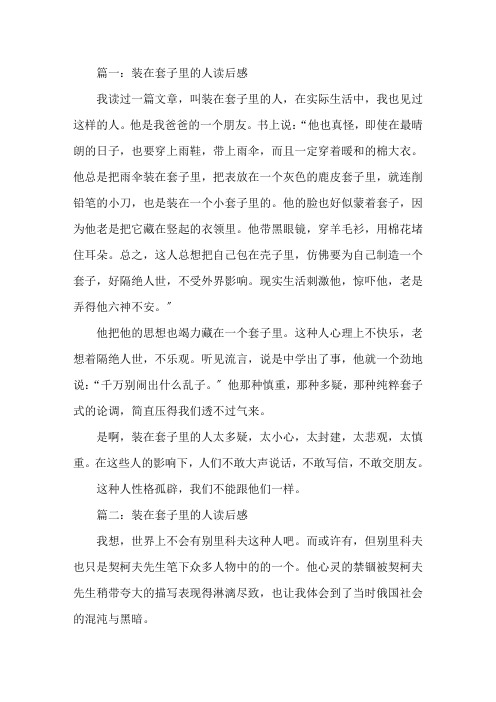
篇一:装在套子里的人读后感我读过一篇文章,叫装在套子里的人,在实际生活中,我也见过这样的人。
他是我爸爸的一个朋友。
书上说:“他也真怪,即使在最晴朗的日子,也要穿上雨鞋,带上雨伞,而且一定穿着暖和的棉大衣。
他总是把雨伞装在套子里,把表放在一个灰色的鹿皮套子里,就连削铅笔的小刀,也是装在一个小套子里的。
他的脸也好似蒙着套子,因为他老是把它藏在竖起的衣领里。
他带黑眼镜,穿羊毛衫,用棉花堵住耳朵。
总之,这人总想把自己包在壳子里,仿佛要为自己制造一个套子,好隔绝人世,不受外界影响。
现实生活刺激他,惊吓他,老是弄得他六神不安。
〞他把他的思想也竭力藏在一个套子里。
这种人心理上不快乐,老想着隔绝人世,不乐观。
听见流言,说是中学出了事,他就一个劲地说:“千万别闹出什么乱子。
〞他那种慎重,那种多疑,那种纯粹套子式的论调,简直压得我们透不过气来。
是啊,装在套子里的人太多疑,太小心,太封建,太悲观,太慎重。
在这些人的影响下,人们不敢大声说话,不敢写信,不敢交朋友。
这种人性格孤辟,我们不能跟他们一样。
篇二:装在套子里的人读后感我想,世界上不会有别里科夫这种人吧。
而或许有,但别里科夫也只是契柯夫先生笔下众多人物中的的一个。
他心灵的禁锢被契柯夫先生稍带夸大的描写表现得淋漓尽致,也让我体会到了当时俄国社会的混沌与黑暗。
世界在转动:人类的科技在不断创新,人类的思想在不断进步,也许在不觉间,人类的身体也在缓慢的进化着。
正如达尔文的自然选择学说一样,只有积极适应环境的生物才会继续生存;一味固守着旧思想、旧事物、旧观念的生命,必会迎来过早的消亡……所以,别里科夫死了,在因恐惧而钻入的套子里——死了,就像契柯夫先生笔下众多的“主人公〞一样。
他的死,也许不仅是一个人的死,也预示着陈旧的事物必将消亡。
如今,我们的社会与当时比起来是如此兴隆,不再有沙俄,也不再有这样残暴的强权;但是,假设人们不能积极、大胆地去接纳新的事物,别里科夫就永远在我们身边。
《装在套子里的人》读后感(优秀4篇)

《装在套子里的人》读后感(优秀4篇)《装在套子里的人》读后感篇一“短篇小说之王”契诃夫,其作品具有批判现实主义的力量。
《装在套子里的人》就是极好的代表,作为主角绿色作文网的别里科夫,人如其言,是个装在套子里的人。
当时的俄国处于无产阶级级革命的前夜,政局动荡,民众两派——守旧派和有新思想的一派。
文中的别里科夫死守旧阵地,仇视和反对一切新鲜事物。
随着时代的发展,人们的生活方式更便利,生活中有太的人把自己装在“保守”的套子里,远离生活,远离人世,避免与新世界接触,坚守顽固思想,不接受创新,害怕改变,过着一复一日的旧日子。
遇到特殊事件后,便会慌张,最终会害了自己。
别里科夫整日穿黑衣,戴黑帽,不接受男女共骑自行车,不接受特殊事件,整日回望过去的“美好”,回望过去什么都没有的日子。
一个人如果长期这样,难免不会一直沉浸于过去,脱离现实。
而时代的发展,也正在淘汰一些终日沉浸于过去的人。
别里科夫只信文告和法令,无论的什么事,他总说“千年万别闹出乱子啊!”他甚至向别人说教,妄想说服他人跟自己一样,别人不信他,他用别样眼光看他。
当有人捉弄他,使他的一天跟往常不一样,这会使他慌乱;当有人做出他思想以外的事,他便会很气恼,因此死去。
文章的结尾,别具深味。
世界上拥有这样的套子人的不知还有多少。
时代在发展,人们应将自己从过去的世界转入新的世界,接受新事物,或许会有别样人生。
装在套子里的人读后感篇二在文章的最开始、布尔金说的那句话就让我的心狠狠的颤动。
希腊文教师别里科夫的死不禁让他感叹,他说:“有些人生性孤僻,他们像寄居蟹或蜗牛那样,总想缩进自己的壳里”是的,别里科夫的一生就是如此的,畏畏缩缩的不敢前行、他将他的所有东西都放在套子里、因为他害怕失去。
他与世隔绝,不受外界的影响,现实生活令他懊丧、害怕,弄得他终日惶惶不安。
也许是为自己的胆怯、为自己对现实的厌恶辩护吧,他总是赞扬过去,赞扬不曾有过的东西。
他有一个古怪的习惯──到同事家串门。
契诃夫《装在套子里的人》读后感
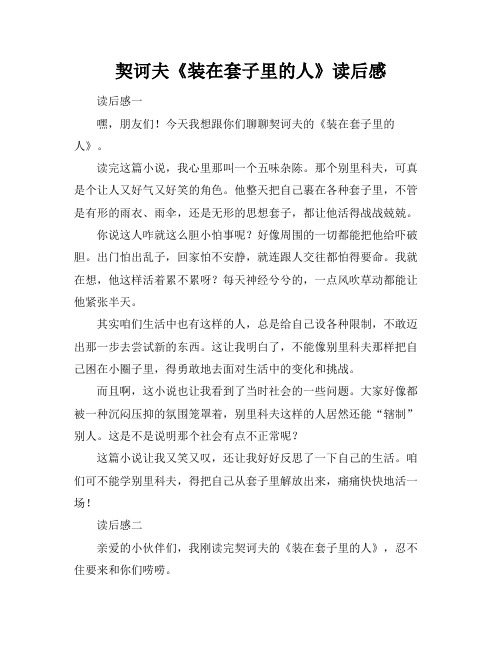
契诃夫《装在套子里的人》读后感读后感一嘿,朋友们!今天我想跟你们聊聊契诃夫的《装在套子里的人》。
读完这篇小说,我心里那叫一个五味杂陈。
那个别里科夫,可真是个让人又好气又好笑的角色。
他整天把自己裹在各种套子里,不管是有形的雨衣、雨伞,还是无形的思想套子,都让他活得战战兢兢。
你说这人咋就这么胆小怕事呢?好像周围的一切都能把他给吓破胆。
出门怕出乱子,回家怕不安静,就连跟人交往都怕得要命。
我就在想,他这样活着累不累呀?每天神经兮兮的,一点风吹草动都能让他紧张半天。
其实咱们生活中也有这样的人,总是给自己设各种限制,不敢迈出那一步去尝试新的东西。
这让我明白了,不能像别里科夫那样把自己困在小圈子里,得勇敢地去面对生活中的变化和挑战。
而且啊,这小说也让我看到了当时社会的一些问题。
大家好像都被一种沉闷压抑的氛围笼罩着,别里科夫这样的人居然还能“辖制”别人。
这是不是说明那个社会有点不正常呢?这篇小说让我又笑又叹,还让我好好反思了一下自己的生活。
咱们可不能学别里科夫,得把自己从套子里解放出来,痛痛快快地活一场!读后感二亲爱的小伙伴们,我刚读完契诃夫的《装在套子里的人》,忍不住要来和你们唠唠。
说起别里科夫,我真是又同情又觉得他活该。
你瞧他,总觉得周围充满了危险,把自己包裹得严严实实的,好像这样就能安全了。
可结果呢?还不是把自己的生活搞得一团糟。
他那种谨小慎微的样子,让我想起了有些人,明明心里想做一件事,却因为害怕这害怕那,啥也没做成。
我就想说,怕啥呀!大不了就是失败,总比一直缩在角落里强吧。
还有啊,别里科夫的爱情也是够悲催的。
好不容易对瓦莲卡有点意思,结果自己那套子思想把这一点点美好也给毁了。
这让我明白,要是心里有想法,就得大胆去追求,别被那些莫名其妙的顾虑给挡住了。
反正读完这书,我就下定决心,要做个自由自在、敢想敢做的人,才不要像别里科夫那样,被一个又一个的套子困住,你们说是不是?。
装在套子里的人课文解析
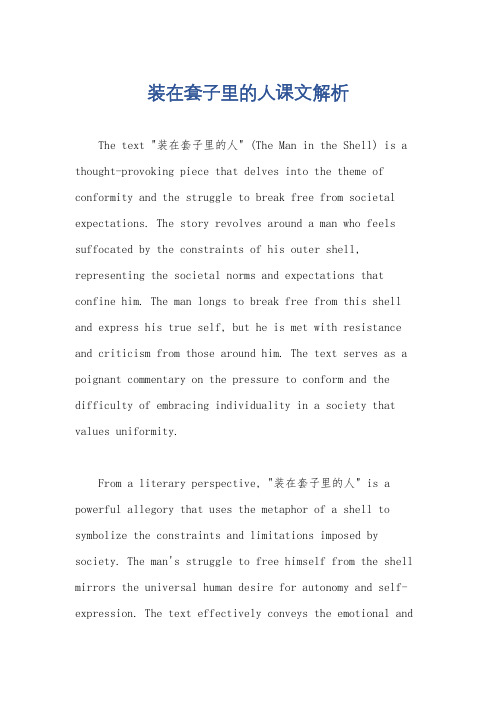
装在套子里的人课文解析The text "装在套子里的人" (The Man in the Shell) is a thought-provoking piece that delves into the theme of conformity and the struggle to break free from societal expectations. The story revolves around a man who feels suffocated by the constraints of his outer shell, representing the societal norms and expectations that confine him. The man longs to break free from this shell and express his true self, but he is met with resistance and criticism from those around him. The text serves as a poignant commentary on the pressure to conform and the difficulty of embracing individuality in a society that values uniformity.From a literary perspective, "装在套子里的人" is a powerful allegory that uses the metaphor of a shell to symbolize the constraints and limitations imposed by society. The man's struggle to free himself from the shell mirrors the universal human desire for autonomy and self-expression. The text effectively conveys the emotional andpsychological turmoil experienced by individuals who feel trapped by societal expectations. Through vivid imagery and evocative language, the author skillfully captures the internal conflict of the protagonist and invites readers to empathize with his plight.Furthermore, the text offers a profound exploration of the human experience and the universal quest for authenticity. The man's yearning to shed his shell and reveal his true self resonates with readers who have grappled with their own identity and the pressure to conform. The story prompts introspection and invites readers to contemplate the ways in which they may be confined by their own metaphorical shells. The text encourages individuals to embrace their uniqueness and resist the urge to mold themselves to fit societal norms.In addition, "装在套子里的人" sheds light on the societal forces that perpetuate conformity and stifle individuality. The reactions of the people around the man, who are quick to criticize and reject his attempts to break free from his shell, reflect the pervasive influence ofsocial expectations. The text serves as a poignant critique of the rigid norms and expectations that govern human behavior and limit personal freedom. By portraying theman's struggle against these forces, the author highlights the importance of challenging societal constraints and embracing one's true self.Moreover, the text invites readers to consider the consequences of suppressing one's authentic self in order to conform. The man's internal turmoil and the conflict between his desire for freedom and the fear of rejection resonate with the emotional struggles faced by many individuals. The story serves as a cautionary tale, reminding readers of the toll that conformity can take on one's mental and emotional well-being. Through the man's journey, the text encourages readers to reflect on the importance of staying true to oneself and the potential for personal growth and fulfillment that comes with embracing individuality.Ultimately, "装在套子里的人" is a poignant and thought-provoking text that offers a profound commentary on thehuman experience. Through its powerful allegory and emotional resonance, the story prompts readers to consider the impact of societal expectations on individual freedom and authenticity. The text serves as a compelling reminder of the importance of embracing one's true self and resisting the pressures to conform. It encourages readers to reflect on their own metaphorical shells and to strive for personal liberation and self-expression.。
装在套子里的人读后感
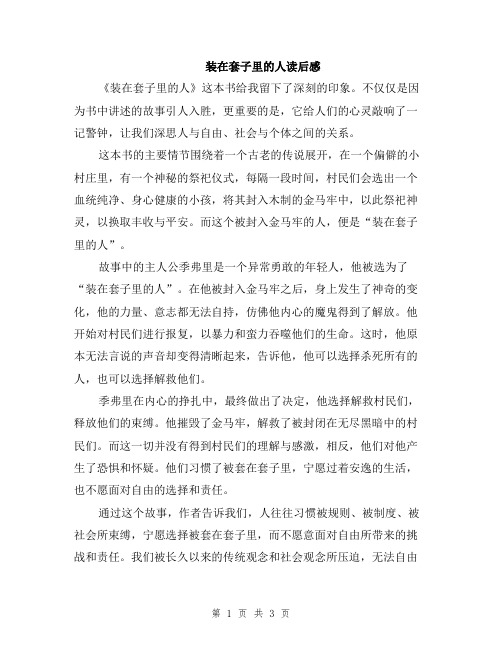
装在套子里的人读后感《装在套子里的人》这本书给我留下了深刻的印象。
不仅仅是因为书中讲述的故事引人入胜,更重要的是,它给人们的心灵敲响了一记警钟,让我们深思人与自由、社会与个体之间的关系。
这本书的主要情节围绕着一个古老的传说展开,在一个偏僻的小村庄里,有一个神秘的祭祀仪式,每隔一段时间,村民们会选出一个血统纯净、身心健康的小孩,将其封入木制的金马牢中,以此祭祀神灵,以换取丰收与平安。
而这个被封入金马牢的人,便是“装在套子里的人”。
故事中的主人公季弗里是一个异常勇敢的年轻人,他被选为了“装在套子里的人”。
在他被封入金马牢之后,身上发生了神奇的变化,他的力量、意志都无法自持,仿佛他内心的魔鬼得到了解放。
他开始对村民们进行报复,以暴力和蛮力吞噬他们的生命。
这时,他原本无法言说的声音却变得清晰起来,告诉他,他可以选择杀死所有的人,也可以选择解救他们。
季弗里在内心的挣扎中,最终做出了决定,他选择解救村民们,释放他们的束缚。
他摧毁了金马牢,解救了被封闭在无尽黑暗中的村民们。
而这一切并没有得到村民们的理解与感激,相反,他们对他产生了恐惧和怀疑。
他们习惯了被套在套子里,宁愿过着安逸的生活,也不愿面对自由的选择和责任。
通过这个故事,作者告诉我们,人往往习惯被规则、被制度、被社会所束缚,宁愿选择被套在套子里,而不愿意面对自由所带来的挑战和责任。
我们被长久以来的传统观念和社会观念所压迫,无法自由地表达自己的想法和追求。
即使是在封建时代结束、社会逐渐进步的今天,在一些保守的地区,仍然存在着对个体自由的限制和约束。
通过季弗里解救村民的过程,作者给我们揭示了一个重要的道理,那就是,自由并不是一种绝对的好处,它需要个体去承担,也需要社会的支持与认可。
在季弗里解救村民的过程中,他所付出的代价是巨大的。
他被诬陷为犯罪分子,被村民们追杀。
最终,他被捉住,沉入了湖底。
他为了解放村民,放弃了自己的生命。
这样一个悲剧的结局让我深感不安。
我们所期望的自由与和平,需要我们每一个人的坚守和奉献。
契诃夫《装在套子里的人》读后感
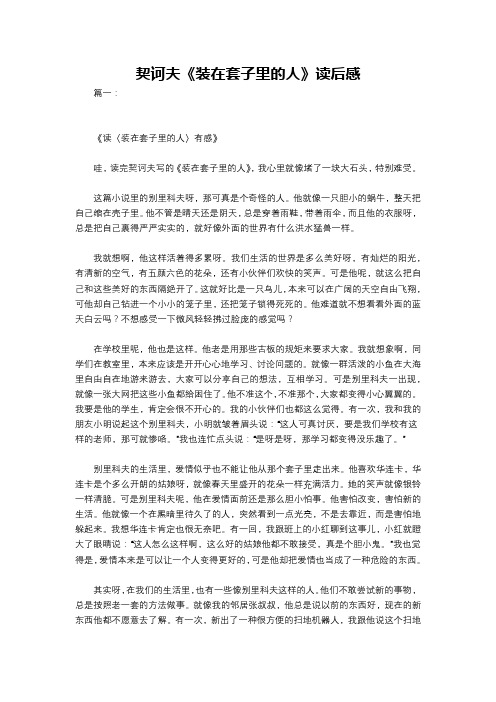
契诃夫《装在套子里的人》读后感篇一:《读〈装在套子里的人〉有感》哇,读完契诃夫写的《装在套子里的人》,我心里就像堵了一块大石头,特别难受。
这篇小说里的别里科夫呀,那可真是个奇怪的人。
他就像一只胆小的蜗牛,整天把自己缩在壳子里。
他不管是晴天还是阴天,总是穿着雨鞋,带着雨伞,而且他的衣服呀,总是把自己裹得严严实实的,就好像外面的世界有什么洪水猛兽一样。
我就想啊,他这样活着得多累呀。
我们生活的世界是多么美好呀,有灿烂的阳光,有清新的空气,有五颜六色的花朵,还有小伙伴们欢快的笑声。
可是他呢,就这么把自己和这些美好的东西隔绝开了。
这就好比是一只鸟儿,本来可以在广阔的天空自由飞翔,可他却自己钻进一个小小的笼子里,还把笼子锁得死死的。
他难道就不想看看外面的蓝天白云吗?不想感受一下微风轻轻拂过脸庞的感觉吗?在学校里呢,他也是这样。
他老是用那些古板的规矩来要求大家。
我就想象啊,同学们在教室里,本来应该是开开心心地学习、讨论问题的。
就像一群活泼的小鱼在大海里自由自在地游来游去,大家可以分享自己的想法,互相学习。
可是别里科夫一出现,就像一张大网把这些小鱼都给困住了。
他不准这个,不准那个,大家都变得小心翼翼的。
我要是他的学生,肯定会很不开心的。
我的小伙伴们也都这么觉得。
有一次,我和我的朋友小明说起这个别里科夫,小明就皱着眉头说:“这人可真讨厌,要是我们学校有这样的老师,那可就惨咯。
”我也连忙点头说:“是呀是呀,那学习都变得没乐趣了。
”别里科夫的生活里,爱情似乎也不能让他从那个套子里走出来。
他喜欢华连卡,华连卡是个多么开朗的姑娘呀,就像春天里盛开的花朵一样充满活力。
她的笑声就像银铃一样清脆。
可是别里科夫呢,他在爱情面前还是那么胆小怕事。
他害怕改变,害怕新的生活。
他就像一个在黑暗里待久了的人,突然看到一点光亮,不是去靠近,而是害怕地躲起来。
我想华连卡肯定也很无奈吧。
有一回,我跟班上的小红聊到这事儿,小红就瞪大了眼睛说:“这人怎么这样啊,这么好的姑娘他都不敢接受,真是个胆小鬼。
套中人读后感800字
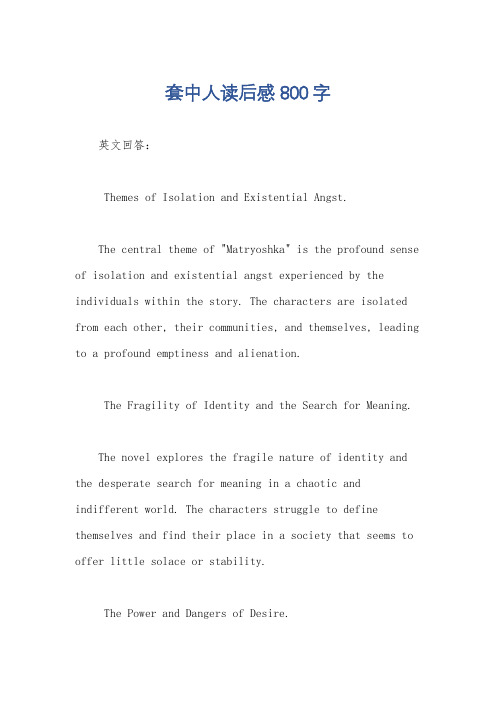
套中人读后感800字英文回答:Themes of Isolation and Existential Angst.The central theme of "Matryoshka" is the profound sense of isolation and existential angst experienced by the individuals within the story. The characters are isolated from each other, their communities, and themselves, leading to a profound emptiness and alienation.The Fragility of Identity and the Search for Meaning.The novel explores the fragile nature of identity and the desperate search for meaning in a chaotic andindifferent world. The characters struggle to define themselves and find their place in a society that seems to offer little solace or stability.The Power and Dangers of Desire.Desire plays a significant role in "Matryoshka,"driving the characters' actions and shaping their destinies. However, the novel also explores the dangers of unchecked desire, which can lead to obsession and destruction.The Role of Memory and the Past.Memory and the past are essential elements in the novel. The characters' present actions and decisions are deeply influenced by their recollections, traumas, and relationships. The past haunts them and shapes their perceptions of the present.The Complexity of Human Nature."Matryoshka" presents a nuanced and complex depictionof human nature. The characters are neither wholly good nor evil but flawed and contradictory individuals strugglingwith their own demons and desires.中文回答:对 "套中人" 的 800 字读后感。
生活中装在套子里的人作文
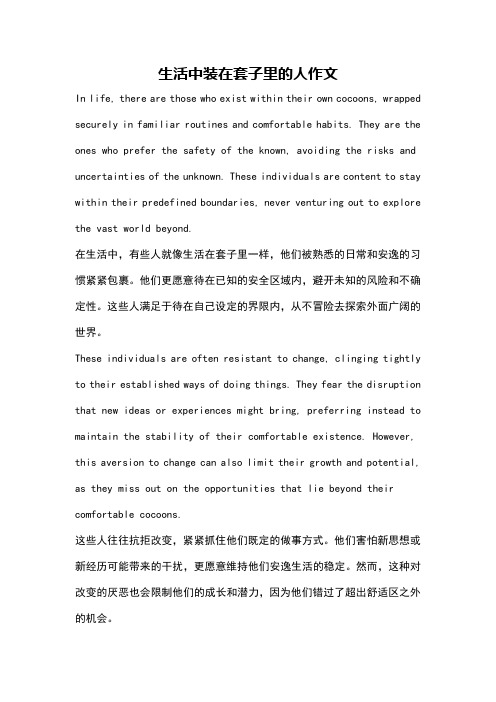
生活中装在套子里的人作文In life, there are those who exist within their own cocoons, wrapped securely in familiar routines and comfortable habits. They are the ones who prefer the safety of the known, avoiding the risks and uncertainties of the unknown. These individuals are content to stay within their predefined boundaries, never venturing out to explore the vast world beyond.在生活中,有些人就像生活在套子里一样,他们被熟悉的日常和安逸的习惯紧紧包裹。
他们更愿意待在已知的安全区域内,避开未知的风险和不确定性。
这些人满足于待在自己设定的界限内,从不冒险去探索外面广阔的世界。
These individuals are often resistant to change, clinging tightly to their established ways of doing things. They fear the disruption that new ideas or experiences might bring, preferring instead to maintain the stability of their comfortable existence. However, this aversion to change can also limit their growth and potential, as they miss out on the opportunities that lie beyond their comfortable cocoons.这些人往往抗拒改变,紧紧抓住他们既定的做事方式。
现实中装在套子里的人英语作文300字
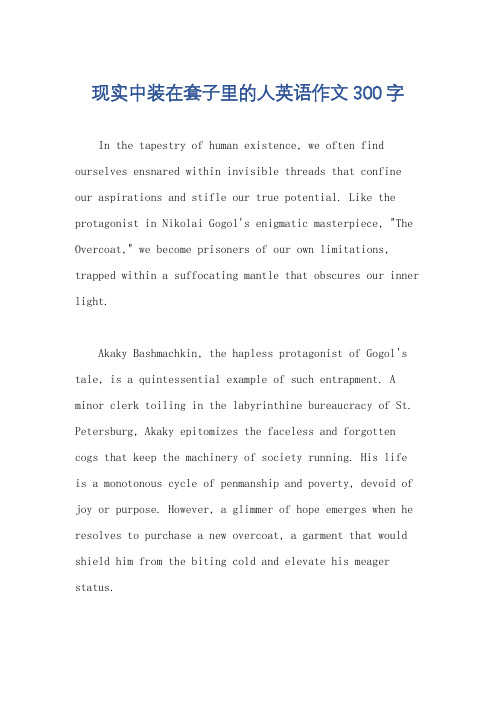
现实中装在套子里的人英语作文300字In the tapestry of human existence, we often find ourselves ensnared within invisible threads that confine our aspirations and stifle our true potential. Like the protagonist in Nikolai Gogol's enigmatic masterpiece, "The Overcoat," we become prisoners of our own limitations, trapped within a suffocating mantle that obscures our inner light.Akaky Bashmachkin, the hapless protagonist of Gogol's tale, is a quintessential example of such entrapment. A minor clerk toiling in the labyrinthine bureaucracy of St. Petersburg, Akaky epitomizes the faceless and forgotten cogs that keep the machinery of society running. His life is a monotonous cycle of penmanship and poverty, devoid of joy or purpose. However, a glimmer of hope emerges when he resolves to purchase a new overcoat, a garment that would shield him from the biting cold and elevate his meager status.Yet, this simple desire becomes an insurmountable obstacle for Akaky. The exorbitant cost of the overcoat forces him to endure years of deprivation and self-denial. He sacrifices basic necessities, subsisting on meagerrations and nursing a gnawing hunger. As he toils away, the overcoat consumes his every thought, becoming a symbol of unattainable aspiration and a cruel reminder of his insignificance.Finally, Akaky realizes his dream, but his joy isshort-lived. On his first night out wearing his new garment, it is stolen, leaving him shattered and utterly lost. The theft is a metaphor for the fragility of his newfoundstatus and the ruthless indifference of the world around him. Stripped of his protective covering, Akaky is once again exposed to the harsh realities of his existence, his spirit broken.In a haunting twist of fate, the stolen overcoat becomes the catalyst for Akaky's transformation. Driven by desperation and a profound sense of injustice, he confronts a high-ranking official, only to be met with contempt anddisdain. This final act of humiliation destroys the last vestiges of hope within him, and Akaky succumbs to illness and death."The Overcoat" is a timeless exploration of the psychological and social forces that trap individualswithin their own limitations. Gogol masterfully depicts the dehumanizing effects of poverty, bureaucracy, and the relentless pursuit of material possessions. Akaky's story serves as a poignant reminder of the importance of recognizing our own value and breaking free from the confines that society attempts to impose upon us.It is crucial to recognize that the "overcoat" in Gogol's tale is not merely a physical garment but a metaphor for the myriad ways in which we allow ourselves to be confined. It could represent our fears, insecurities, societal expectations, or any other force that prevents us from living authentically. Just as Akaky was imprisoned by his obsession with the overcoat, we too can become trapped within the narrow confines of our own minds.To break free from these invisible chains, we must embark on a journey of self-discovery and personal growth. This journey requires courage, resilience, and a willingness to challenge the status quo. We must learn to embrace our own unique identities and pursue our passions, regardless of the obstacles we may face.The legacy of "The Overcoat" endures because it speaks to the universal human experience of seeking significance and escaping the confines of our limitations. By recognizing the metaphorical overcoats that weigh us down, we can take the first step towards liberation and live lives that are truly our own.。
The Man in a Case装在套子里的人英语读后感
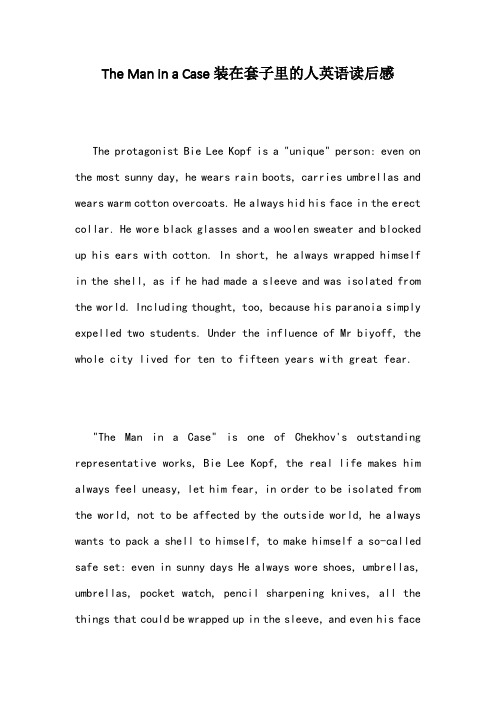
The Man in a Case装在套子里的人英语读后感The protagonist Bie Lee Kopf is a "unique" person: even on the most sunny day, he wears rain boots, carries umbrellas and wears warm cotton overcoats. He always hid his face in the erect collar. He wore black glasses and a woolen sweater and blocked up his ears with cotton. In short, he always wrapped himself in the shell, as if he had made a sleeve and was isolated from the world. Including thought, too, because his paranoia simply expelled two students. Under the influence of Mr biyoff, the whole city lived for ten to fifteen years with great fear."The Man in a Case" is one of Chekhov's outstanding representative works, Bie Lee Kopf, the real life makes him always feel uneasy, let him fear, in order to be isolated from the world, not to be affected by the outside world, he always wants to pack a shell to himself, to make himself a so-called safe set: even in sunny days He always wore shoes, umbrellas, umbrellas, pocket watch, pencil sharpening knives, all the things that could be wrapped up in the sleeve, and even his faceseemed to be in the sleeve, because he always hid his face in the erect collar, wearing black glasses, cotton in his ear and sitting out. When the cart is rented, the driver needs to pull up the hood immediately. This is only the external manifestation of his fear. On the other hand, all the prohibited things made him feel solid and clear, and he felt suspicious and afraid of everything that had not been banned by the government. One of his pet phrases is "never let anything happen." In this short length novel, this sentence has appeared nine times in different ways. It is just like a curse. What is particularly intolerable is that he always visits every teacher's domicile like a ghost, sitting for one or two hours without saying a word, and then disappearing like a ghost. His fear spread like a cancer and spread to everyone around him. He stayed in school for 15 years, and the whole school and even the whole city was controlled for 15 years. No one wanted to resist in such a long time, and wanted to say no words to him. People in the city are afraid of anything: dare not speak loudly, dare not send letters, make friends, read books, dare not help the poor, teach people to read, dare not eat meat, play cards, and dare not engage in any recreational activities. People are like him to curl up in their own sleeves and live to steal aliving.Not only the society at that time, but also the present era. Although it is a pursuit of democracy, is it really true? Maybe this kind of person is not obvious, but it can not deny their existence. Today's laws and regulations are the best examples. Is there a lot of things that are stipulated in it, isn't it to hold us? In Chinese education, it is very small to kill the children's imagination, coercion, impose the only standard answers on the children, no longer give them imagination, and make them unchangeable. Chinese creativity is strangled like this. Thoughts and behaviors are all put in the covers.Chekhov's creation is basically inclined to criticize realism. He is good at revealing a typical social theme through ordinary daily life. In order to achieve this goal, he uses the art of humor to ridicule the ugly social reality and form a style of his creative writing: humorous satire. In the novel the man in the middle, this novel has been humorous and satirical from beginning to end to show the character of biicoff. At thebeginning of the novel, he wrote about the portraits and habits of his life: "he is famous because he wears rain shoes and umbrellas on a sunny day, and must wear a warm cotton coat." His umbrella is always wrapped up in sleeves. The watch is also wrapped in a gray leather cover, and even a small knives for sharpening pencils are also put in the covers. He wrote the ugly face of Bie Li Fu, saying that "the little face like a weasel's face." It also "managed the whole secondary school for fifteen years" and so on. These portrayals are almost exaggerated, however, Chekhov is using this humorous tone to write such a way to kill all new things, not hesitate to use stare, whistle, and other mean means, make the whole city afraid of his small image, appeal to people to change the society.版权作品,未经《99作文网》书面授权,严禁转载,违者将被追究法律责任。
《装在套子里的人》读后感
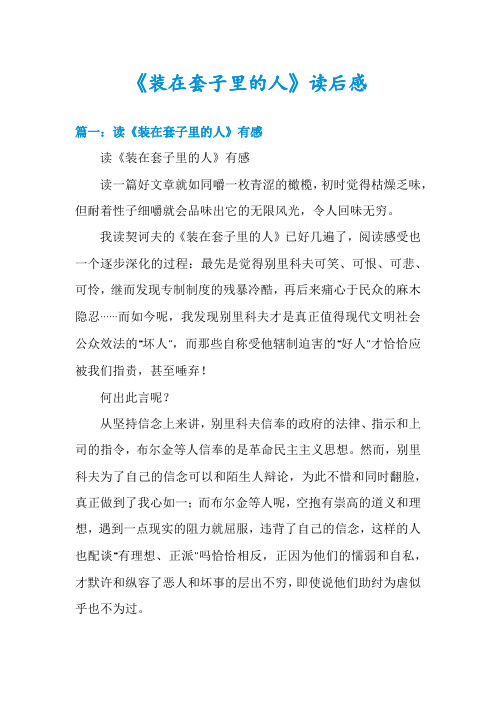
《装在套子里的人》读后感篇一:读《装在套子里的人》有感读《装在套子里的人》有感读一篇好文章就如同嚼一枚青涩的橄榄,初时觉得枯燥乏味,但耐着性子细嚼就会品味出它的无限风光,令人回味无穷。
我读契诃夫的《装在套子里的人》已好几遍了,阅读感受也一个逐步深化的过程:最先是觉得别里科夫可笑、可恨、可悲、可怜,继而发现专制制度的残暴冷酷,再后来痛心于民众的麻木隐忍……而如今呢,我发现别里科夫才是真正值得现代文明社会公众效法的“坏人”,而那些自称受他辖制迫害的“好人”才恰恰应被我们指责,甚至唾弃!何出此言呢?从坚持信念上来讲,别里科夫信奉的政府的法律、指示和上司的指令,布尔金等人信奉的是革命民主主义思想。
然而,别里科夫为了自己的信念可以和陌生人辩论,为此不惜和同时翻脸,真正做到了我心如一;而布尔金等人呢,空抱有崇高的道义和理想,遇到一点现实的阻力就屈服,违背了自己的信念,这样的人也配谈“有理想、正派”吗恰恰相反,正因为他们的懦弱和自私,才默许和纵容了恶人和坏事的层出不穷,即使说他们助纣为虐似乎也不为过。
其次,别里科夫明知科瓦连科非常讨厌自己,可他在自身道德感和责任感的驱使下,还是硬着头皮去登门造访,郑重表达对科瓦连科的劝诫和担忧,丝毫不顾这会招致对方多大反感;而包括“我”在内的其他人呢,他们躲在自己虚伪的“善心”幌子下,提心吊胆,不敢接济穷人,不敢交朋友,不敢教别人念书、写字…….他们的卑怯,比起别里科夫相去何止以“里”计算。
无论古今中外,“好人”总是有一些聊以自慰的空洞口号为自己的自私、胆怯做遮羞布,用自己的“善良”的动机代替那些实实在在伪善的行为。
何况,别里科夫死后,按理来说那些受他管制的“好人”们本该自由呼吸,扬眉吐气了吧!可事实上是他们的生活很快就恢复了以前的老样子,难道这也能归罪于别里科夫吗?专制统治确实残暴,英国有位思想家曾说过:“专制使人沉默,但这种责任不能只推给君主皇帝”,鲁迅先生也曾说过,暴君之所以能够肆意妄为,是因为他们的统治小有太多的奴才和顺民。
《装在套子里的人》

装在套子里的人在生活中,我们常常会遇到许多“装在套子里”的人。
他们看起来与外界保持着一定的距离,很少敞开心扉与他人交流。
他们的内心丰富而复杂,但是表面上的外貌却相对平淡无奇。
那么,他们为什么会“装在套子里”呢?紧张和自卑许多人因为自卑感而选择“装在套子里”,不敢敞开心扉跟别人交流。
他们面对陌生的环境或人群时总是感到紧张和不安,常常拘谨得像个陌生人。
他们担心被别人嘲笑或质疑,因此选择保持距离和沉默。
但是,这种抱怨自我保护的态度过于消极,会让他们在人际关系中逐渐被孤立。
因此,他们需要更勇敢的面对自己的内心,积极追求与他人交流和互动的机会。
保护自己的内心世界还有一些人之所以“装在套子里”,是因为他们拥有丰富而独特的内心世界,希望借此保护他们的思想和情感。
他们很清楚自己的内心世界是与众不同的,因此不愿意轻易地向外界展示出来。
他们认为只有被信任的人才有资格了解自己的内心,其他人怎样也无法理解也许只有他们才拥有的情感与思想。
正是因为他们与众不同,所以才更需要勇气去敞开自己的心扉,让别人了解自己,这样才有机会得到更多的认知和认可。
怎样走出套子?如果想要走出“装在套子里”的状态,我们需要认识和面对自己的内心,勇敢地跟别人沟通和交流。
以下是一些建议:1. 关注自己的情感与情绪在生活中,我们总是被各种事情所困扰,难以自拔。
我们需要时刻关注自己的情感和情绪,理解自己内心的真正需求,适时地调整自己的心态和情绪。
2. 积极追求和他人的互动和别人交往和互动不仅能丰富自己的人生经验,更能获得别人的认可和支持。
我们需要积极寻找机会,与身边的人建立联系并建立深入的交流。
3. 接受自己的独特性每个人都是独特而珍贵的,拥有自己的思想和情感。
我们需要认识和接受自己的独特之处,以此来自信地面对内心的世界。
4. 努力培养自己的兴趣爱好兴趣爱好是人生的春风,可以给我们的生活带来无限的乐趣和意义。
我们需要尽量地培养自己的兴趣爱好,丰富自己的生活,以此来塑造自己更为独立而丰富的内心世界。
《装在套子里的人》
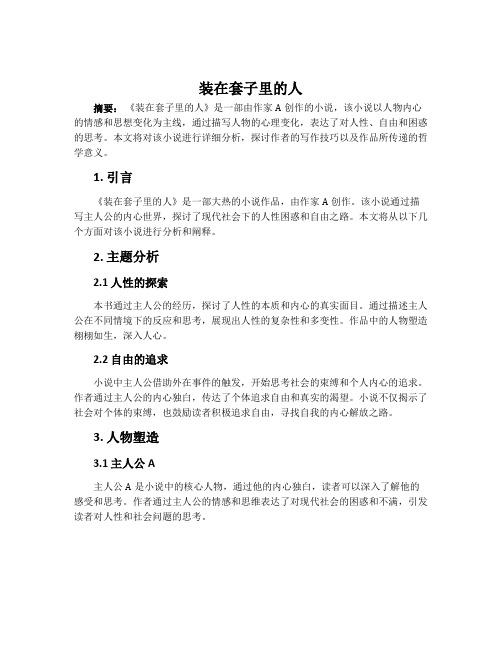
装在套子里的人摘要:《装在套子里的人》是一部由作家A创作的小说,该小说以人物内心的情感和思想变化为主线,通过描写人物的心理变化,表达了对人性、自由和困惑的思考。
本文将对该小说进行详细分析,探讨作者的写作技巧以及作品所传递的哲学意义。
1. 引言《装在套子里的人》是一部大热的小说作品,由作家A创作。
该小说通过描写主人公的内心世界,探讨了现代社会下的人性困惑和自由之路。
本文将从以下几个方面对该小说进行分析和阐释。
2. 主题分析2.1 人性的探索本书通过主人公的经历,探讨了人性的本质和内心的真实面目。
通过描述主人公在不同情境下的反应和思考,展现出人性的复杂性和多变性。
作品中的人物塑造栩栩如生,深入人心。
2.2 自由的追求小说中主人公借助外在事件的触发,开始思考社会的束缚和个人内心的追求。
作者通过主人公的内心独白,传达了个体追求自由和真实的渴望。
小说不仅揭示了社会对个体的束缚,也鼓励读者积极追求自由,寻找自我的内心解放之路。
3. 人物塑造3.1 主人公A主人公A是小说中的核心人物,通过他的内心独白,读者可以深入了解他的感受和思考。
作者通过主人公的情感和思维表达了对现代社会的困惑和不满,引发读者对人性和社会问题的思考。
3.2 配角BB是主人公A的挚友,他的形象构建了主人公内心的对比。
B代表了那些盲目追求社会成功和物质利益的人,通过与主人公的对话和互动,B的形象更加鲜活,使读者更能反思现代社会的问题。
4. 叙事风格本书采用了一种现实主义的叙事风格,突出了主人公A的内心世界,以推动情节的发展。
作者通过对内心感受的描写和主人公的内心独白,使读者更能感受到主人公的情感变化和思考过程。
这种直接的叙述方式使小说更加贴近读者,增加了情感共鸣。
5. 文学价值与哲学意义5.1 文学价值《装在套子里的人》作为一部现实主义小说,不仅描写了现代社会中人性的复杂性和困惑,还通过对主人公的心理描写,探讨了个体内心的解放和追求自由的意义。
- 1、下载文档前请自行甄别文档内容的完整性,平台不提供额外的编辑、内容补充、找答案等附加服务。
- 2、"仅部分预览"的文档,不可在线预览部分如存在完整性等问题,可反馈申请退款(可完整预览的文档不适用该条件!)。
- 3、如文档侵犯您的权益,请联系客服反馈,我们会尽快为您处理(人工客服工作时间:9:00-18:30)。
The Man in a Case_装在套子里的人英语读后感
The protagonist Bie Lee Kopf is a "unique" person: even on the most sunny day, he wears rain boots, carries umbrellas and wears warm cotton overcoats. He always hid his face in the erect collar. He wore black glasses and a woolen sweater and blocked up his ears with cotton. In short, he always wrapped himself in the shell, as if he had made a sleeve and was isolated from the world. Including thought, too, because his paranoia simply expelled two students. Under the influence of Mr biyoff, the whole city lived for ten to fifteen years with great fear.
"The Man in a Case" is one of Chekhov's outstanding representative works, Bie Lee Kopf, the real life makes him always feel uneasy, let him fear, in order to be isolated from the world, not to be affected by the outside world, he always wants to pack a shell to himself, to make himself a so-called safe set: even in sunny days He always wore shoes, umbrellas, umbrellas, pocket watch, pencil sharpening knives, all the things that could be wrapped up in the sleeve, and even his face seemed to be in the sleeve, because he always hid his face in the erect collar, wearing
black glasses, cotton in his ear and sitting out. When the cart is rented, the driver needs to pull up the hood immediately. This is only the external manifestation of his fear. On the other hand, all the prohibited things made him feel solid and clear, and he felt suspicious and afraid of everything that had not been banned by the government. One of his pet phrases is "never let anything happen." In this short length novel, this sentence has appeared nine times in different ways. It is just like a curse. What is particularly intolerable is that he always visits every teacher's domicile like a ghost, sitting for one or two hours without saying a word, and then disappearing like a ghost. His fear spread like a cancer and spread to everyone around him. He stayed in school for 15 years, and the whole school and even the whole city was controlled for 15 years. No one wanted to resist in such a long time, and wanted to say no words to him. People in the city are afraid of anything: dare not speak loudly, dare not send letters, make friends, read books, dare not help the poor, teach people to read, dare not eat meat, play cards, and dare not engage in any recreational activities. People are like him to curl up in their own sleeves and live to steal a living.
Not only the society at that time, but also the present era. Although it is a pursuit of democracy, is it really true? Maybe this kind of person is not obvious, but it can not deny their existence. Today's laws and regulations are the best examples. Is there a lot of things that are stipulated in it, isn't it to hold us? In Chinese education, it is very small to kill the children's imagination, coercion, impose the only standard answers on the children, no longer give them imagination, and make them unchangeable. Chinese creativity is strangled like this. Thoughts and behaviors are all put in the covers.
Chekhov's creation is basically inclined to criticize realism. He is good at revealing a typical social theme through ordinary daily life. In order to achieve this goal, he uses the art of humor to ridicule the ugly social reality and form a style of his creative writing: humorous satire. In the novel the man in the middle, this novel has been humorous and satirical from beginning to end to show the character of biicoff. At the beginning of the novel, he wrote about the portraits and habits of his life: "he is famous because he wears rain shoes and umbrellas on a sunny day, and must wear a warm cotton coat." His umbrella is
always wrapped up in sleeves. The watch is also wrapped in a gray leather cover, and even a small knives for sharpening pencils are also put in the covers. He wrote the ugly face of Bie Li Fu, saying that "the little face like a weasel's face." It also "managed the whole secondary school for fifteen years" and so on. These portrayals are almost exaggerated, however, Chekhov is using this humorous tone to write such a way to kill all new things, not hesitate to use stare, whistle, and other mean means, make the whole city afraid of his small image, appeal to people to change the society.。
